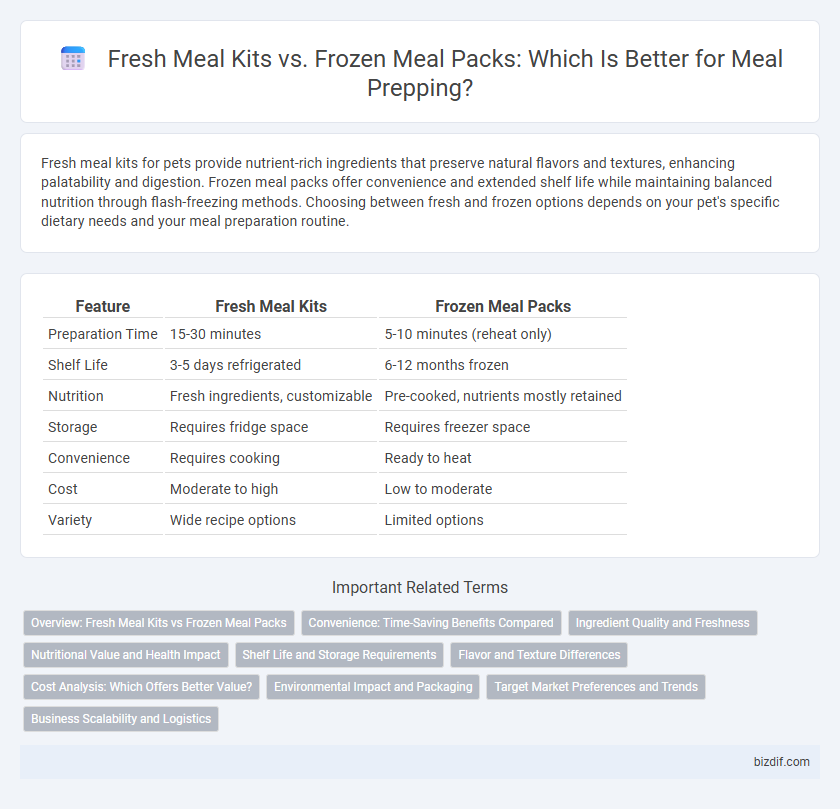Fresh meal kits for pets provide nutrient-rich ingredients that preserve natural flavors and textures, enhancing palatability and digestion. Frozen meal packs offer convenience and extended shelf life while maintaining balanced nutrition through flash-freezing methods. Choosing between fresh and frozen options depends on your pet's specific dietary needs and your meal preparation routine.
Table of Comparison
| Feature | Fresh Meal Kits | Frozen Meal Packs |
|---|---|---|
| Preparation Time | 15-30 minutes | 5-10 minutes (reheat only) |
| Shelf Life | 3-5 days refrigerated | 6-12 months frozen |
| Nutrition | Fresh ingredients, customizable | Pre-cooked, nutrients mostly retained |
| Storage | Requires fridge space | Requires freezer space |
| Convenience | Requires cooking | Ready to heat |
| Cost | Moderate to high | Low to moderate |
| Variety | Wide recipe options | Limited options |
Overview: Fresh Meal Kits vs Frozen Meal Packs
Fresh meal kits offer pre-portioned, high-quality ingredients that preserve texture and flavor, ideal for quick cooking and customizable meals. Frozen meal packs provide long shelf life and convenience, with pre-cooked components that maintain nutritional value through flash-freezing technology. Choosing between fresh meal kits and frozen meal packs depends on preferences for meal freshness, preparation time, and storage requirements.
Convenience: Time-Saving Benefits Compared
Fresh meal kits offer time-saving benefits by providing pre-portioned ingredients that reduce meal prep and cooking time, ideal for busy individuals seeking quick, nutritious dinners. Frozen meal packs extend convenience through longer shelf life and instant readiness, enabling effortless meal solutions without daily shopping or extensive preparation. Choosing between fresh and frozen depends on whether immediate freshness or long-term storage efficiency best suits your lifestyle needs.
Ingredient Quality and Freshness
Fresh meal kits prioritize high-quality, seasonal ingredients delivered shortly before cooking, ensuring maximum freshness and optimal nutrient retention. Frozen meal packs maintain ingredient freshness through rapid freezing techniques that lock in flavor and nutrients but may slightly alter texture upon thawing. Selecting between the two depends on preference for fresh taste versus convenience and extended shelf life.
Nutritional Value and Health Impact
Fresh meal kits retain higher levels of vitamins and antioxidants due to minimal processing, supporting better immune function and overall health. Frozen meal packs often lose some nutrient density during freezing and thawing but offer convenience with longer shelf life and reduced food waste. Choosing fresh meal kits promotes optimal nutrient absorption, while frozen packs provide a practical alternative for maintaining balanced meals.
Shelf Life and Storage Requirements
Fresh meal kits typically have a shelf life of 3 to 5 days and require refrigeration at temperatures between 34degF and 40degF to maintain optimal freshness. Frozen meal packs can be stored for several months, often up to 6 months, when kept at consistently low temperatures of 0degF or below, ensuring long-term preservation. Proper storage conditions directly impact the flavor, texture, and nutritional quality of both fresh and frozen meals.
Flavor and Texture Differences
Fresh meal kits deliver vibrant flavors and crisp textures due to the use of fresh ingredients that retain their natural taste and nutrient profile. Frozen meal packs often experience slight changes in texture, such as softer vegetables and less tender proteins, caused by the freezing and thawing process. Flavor intensity can diminish in frozen packs as freezing may dilute seasonings and alter the overall taste experience compared to fresh meal kits.
Cost Analysis: Which Offers Better Value?
Fresh meal kits typically cost more upfront due to premium ingredients and customization options, averaging $8 to $12 per serving, while frozen meal packs range from $4 to $7 per serving, offering a budget-friendly alternative. However, fresh meal kits reduce food waste with precise portions and often include higher nutritional value, potentially lowering long-term health-related expenses. Consumers seeking convenience and cost savings may prefer frozen packs, but those prioritizing ingredient quality and meal variety might find fresh kits deliver better overall value.
Environmental Impact and Packaging
Fresh meal kits typically use biodegradable or recyclable packaging materials, reducing plastic waste and lowering environmental footprints compared to frozen meal packs, which often rely on single-use plastic and insulating materials. The transportation of fresh meal kits involves more frequent deliveries with refrigerated vehicles, potentially increasing carbon emissions, while frozen meal packs benefit from longer shelf life and consolidated shipping, improving overall supply chain efficiency and reducing per-meal emissions. Prioritizing sustainable sourcing, minimal packaging, and optimized delivery logistics are crucial factors in minimizing the environmental impact of both meal prepping options.
Target Market Preferences and Trends
Fresh meal kits appeal primarily to health-conscious consumers and busy professionals seeking convenience without compromising nutrition, aligning with trends favoring organic, locally sourced ingredients. Frozen meal packs attract budget-focused individuals and families prioritizing long shelf life and ease of storage, benefiting from innovations in flash-freezing technology that preserve flavor and nutrients. Market data shows increasing demand for customizable options in fresh meal kits, while frozen packs see steady growth due to rising interest in meal variety and portion control.
Business Scalability and Logistics
Fresh meal kits demand stringent cold chain logistics and rapid delivery systems, increasing complexity and operational costs but enhancing product quality and customer satisfaction. Frozen meal packs offer extended shelf life and simplified inventory management, allowing businesses to scale distribution geographically without compromising food safety. Balancing fresh kit perishability with frozen pack durability is critical for optimizing scalability and reducing logistical challenges.
Fresh Meal Kits vs Frozen Meal Packs Infographic

 bizdif.com
bizdif.com